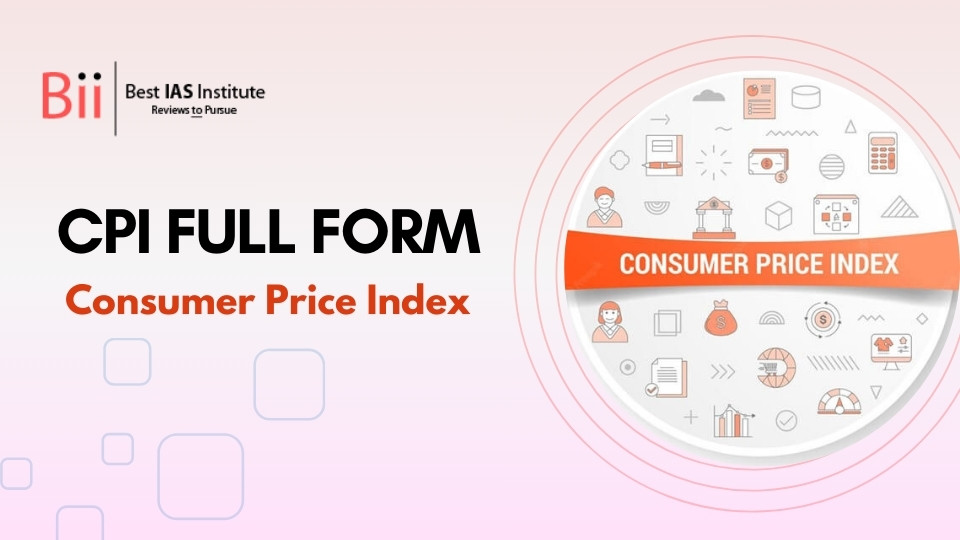
What is CPI Full Form?
CPI stands for “Consumer Price Index”. This measure is used to track changes in the prices of a basket of goods and services over time, and is often used to monitor inflation The Consumer Price Index (CPI) is an important economic metric used to measure the increase in the price of a basket of consumer goods and services and inflation in general is the measure used.
What is the Consumer Price Index (CPI) ?
The Consumer Price Index (CPI) is an economic indicator that measures the average change over time in the prices paid by urban consumers for a market basket of consumer goods and services. It is used to assess price changes associated with the cost of living and is a key indicator of inflation. CPI data is crucial for adjusting income payments, wages, and pensions to maintain purchasing power.
Types of Consumer Price Index (CPI)
The following are different types of Consumer Price Indexes (CPIs), each designed to measure price changes of specific categories of goods and services or to serve a specific purpose;
- All goods CPI: The most commonly referred to as the CPI, and it measures the price fluctuations of a large basket of goods and services consumed by an average household and it is used to measure inflation across the economy.
- Core CPI: Core CPI excludes certain volatilities, such as food and energy prices and it can experience significant short-term fluctuations and is used to get a clearer picture of inflation, as these variables can distort the overall CPI.
- Food CPI: The index tracks changes in food prices, including groceries and eating out and it is especially important because food costs are a big part of most people’s budgets.
- Energy Consumer Price Index (CPI): They only focus on changes in energy-related costs, such as gas, electricity, heating oil and energy prices can be volatile and have a significant impact on household finances.
- Housing CPI: The Housing CPI primarily looks at changes in housing costs, including rent and mortgage interest and the cost of housing are a major factor in the cost of an average home.
- Medical Care CPI: The medical care CPI tracks changes in prices for medications, prescription drugs, and health care spending and the importance of healthcare costs and it also helps assess the impact of rising medical costs on consumers.
- Transportation CPI: The Transportation CPI measures changes in the cost of owning and operating vehicles, as well as public transportation costs and CPI provides insight into how travel costs affect consumers.
Application of Consumer Price Index (CPI)
The Following Consumer Price Index (CPI) important applications in economics, finance, policy making and everyday life:
- The primary function of the CPI is to measure inflation and it provides a reliable record of how the cost of living changes over time, helping individuals and businesses understand the impact of inflation on their budgets and investment decisions.
- Many labour contracts, including collective bargaining agreements and employment agreements, use the CPI as the basis for wage adjustments and they ensure that workers’ wages continue to keep pace with rising costs of living.
- Government programs like Social Security often use the CPI to determine retiree living adjustments and the plans for pensions can also use CPI data to calculate pension benefits.
- The Central banks and governments use CPI data to formulate and evaluate monetary and fiscal policy such that central banks can set interest rates based on CPI developments to control inflation.
- Banks and monetary policy makers use CPI data to prepare monetary policy with examine the real return on investment to calculate inflation.
Benefits of Consumer Price Index (CPI)
The Benefits of Consumer Price Index (CPI) offers a number of benefits and importance to individuals, businesses, policy makers and the wider economy:
- Budgeting and monetary policy: The CPI helps in budgeting and monetary policy by highlighting the fluctuations in the prices of commonly purchased goods and services and it also allows people to adjust spending and saving accordingly.
- Wage and Benefit Adjustments: The CPI Employment contracts, pension plans, and many government programs use the CPI to determine wage increases and living adjustments and also ensure that wages and benefits keep pace with inflation.
- Monetary Policy: The Central banks and policymakers use CPI data to make decisions about interest rates and other monetary policy and they help them deal with inflation and sustain economic stability.
- Investment Decision: The Investors rely on CPI data to determine the real return on investment after accounting for inflation and they will provide some investment strategies and asset allocation decisions.
- Business planning: Companies use CPI characteristics to make pricing decisions, plan production and inventory, and forecast changes in operating costs and it helps them adapt to customer behaviour and market conditions.
- Real Estate Decisions: Real estate agents and investors use Consumer Price Index CPI data to set rental rates, assess property values, and make property development and management decisions.
How to Calculate Consumer Price Index (CPI) ?
The formula for calculating the Consumer Price Index (CPI) has many steps and a variety of factors and weights assigned to the various goods and services in the basket Here is the basic framework and about the steps given below:
The following steps to calculate the Consumer Price Index ( CPI):
- Basket Selection: Identify items and their quantities that represent each household’s usage pattern. This creates a “basket of goods and services”.
- Weight: Give each item in the basket a weight to reflect its importance in the buyer’s budget such as housing costs may exceed leisure.
- Aggregate Price: Aggregate the current price of each item in the year of the current basket and it usually involves visiting stores, checking prices online, and doing research.
- Calculate the cost of the basket for the current year: Multiply the cost of each item by its weight, and add up the cost of all items and this yields the total cost of the basket for the current year.
- Collecting Base Year Prices: They collect the prices of the same items in the basket for the base year.
- Calculate the cost of the basket in the installation year: Multiply the price of each item in the base year by its weight and add these costs together and this will provide the total cost of the basket for the base year.
- Calculation of the Consumer Price Index (CPI) : To calculate the Consumer Price Index (CPI) = (The Total cost of basket in current year / The Total cost of basket in base year) x and divide the total cost of the basket in the current year by the total cost of the cap in the base year and then multiply by 100 around.
| Consumer Price Index (CPI) = (The Total cost of basket in current year / The Total cost of basket in base year) x 100 |
Conclusion
The CPI Full Form is Consumer Price Index and it is an important economic indicator of inflation and changes in living standards and it is important for businesses, governments and individuals to effectively monitor economic growth. While inflation fluctuates around the world, it also remains a cornerstone of inflation and informed investment choices and up to date with CPI updates to make informed decisions in the ever-evolving economic environment.
Also Read:
OECD Full Form
ED Full Form
CSIR Full Form
UPSC Full Form
NET Full Form
NITI Full Form
UCC Full Form
IC Full Form
PIL Full Form
IES Full Form
MSP Full Form



